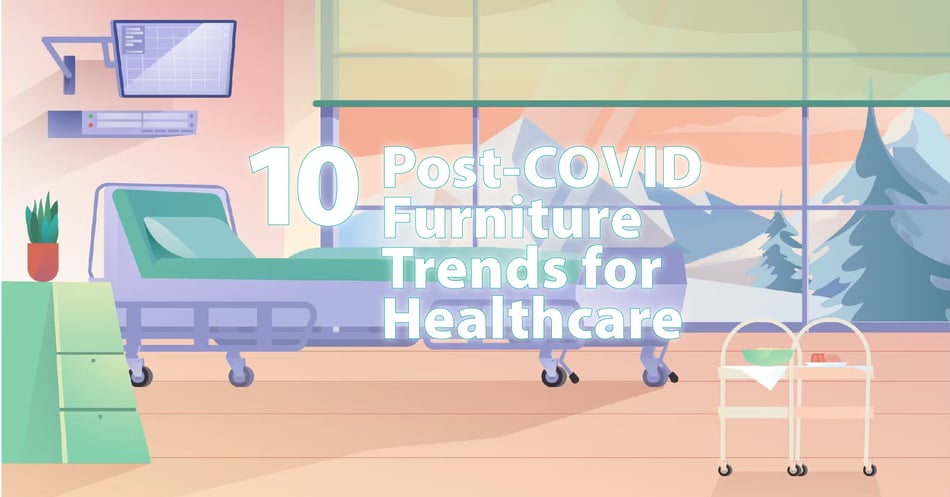10 Post-COVID Furniture Trends for Healthcare

 During a time when hospitals are under unimaginable stresses from a global pandemic, thinking about furniture choices might seem frivolous. However, despite the ongoing surge in COVID-19, hospitals must be built, renovated, and and expanded. And a huge part of those construction projects is selecting the furniture that will serve the patients, their families, and the staff. Today we look at what will influence those decisions in the coming year, including infection prevention.
During a time when hospitals are under unimaginable stresses from a global pandemic, thinking about furniture choices might seem frivolous. However, despite the ongoing surge in COVID-19, hospitals must be built, renovated, and and expanded. And a huge part of those construction projects is selecting the furniture that will serve the patients, their families, and the staff. Today we look at what will influence those decisions in the coming year, including infection prevention.
These are the trends that will persist in hospital furniture thanks to best practices and cleanability, as well as ensure that the pieces are good investments (with even a return on investment!)
#1 Non-Porous Materials - It's essential that materials near the patient not retain moisture or organic matter, which can serve as a breeding ground for disease-causing bacteria as well as break down the furniture over time. High-touch surfaces should be made from a non-porous material that is easy to clean. Biocidal, non-porous materials are ideal.
#2 Moisture-Proof Textiles - From curtains (if you must have them) to seating, textiles must be moisture-proof. This protects the textile from mold and mildew and makes them easier to clean. Any rips or tears must always be repaired or replaced so that moisture cannot find its way into the wood or padding underneath.
#3 Single-Material Arm Caps - Arm rests are high-touch surfaces both in the waiting room and the patient room. They should be made from one single material to avoid seams and ridges that can be a reservoir for bacteria. Biocidal solid surface arm caps are preferred.
#4 Clean-Out Gaps in Seating - Clean-out gaps are intentional holes in the chair that are designed to allow for easier cleaning and prevent the accumulation of debris in hard-to-reach areas. These are often seen in the back of solid and textile seating.
#5 Must Withstand Harsh Cleaners - Bleach and other cleaners are a part of our daily lives now, all the more so in a healthcare facility. Any material selected for a hospital must be able to withstand frequent cleaning with harsh chemicals. Degradation in furniture (removal of protective vinyl coating, for example) also opens avenues for bacteria to survive and reproduce.
#6 Built-In Charging Stations - Access to an electrical or USB outlet is critical to today's computerized world. Patients will want to have access to their own devices, if possible, and visitors will appreciate the ability to charge theirs as they tend to a loved one.
#7 Multi-Use Pieces - There are financial pressures on hospitals that are here to stay. To this end, furniture with multiple uses will be a cost-effective way to equip a room. Armchairs that turn into sleepers, night-stands that can become work surfaces, and many other options will reach the marketplace. Modular pieces that work in different spaces will also be popular.
#8 Home-Like Environment - The need to provide patient satisfaction will continue to be a priority. To this end, designing hospital environments that echo the comforts and color palettes of home will continue to influence furniture choices. Natural (or natural-looking) materials such as wood grain laminate and stone-like surfaces will be popular.
#9 Integrated Wayfinding - With a busy (and often understaffed) hospital, having clear wayfinding systems will be essential. Hospitals will continue to explore ways of integrating wayfinding into design, including embedding technology into walls, creating wayfinding apps, and using flooring to indicate directions and departments.
#10 Biocidal Materials - Now, more than ever, even the general public is aware of the role surfaces play in the transmission of pathogens. Healthcare designers are also learning that their furniture choices can positively impact patient outcomes. With more and more hospitals aware of the need for actual biocidal (rather than "antimicrobial") surfaces, the general public will welcome seeing materials that kill dangerous bacteria and viruses. Hospital-associated infections persist despite increased attention to handwashing and disinfections, due in great part to the fact that regular surfaces accumulate significant bacteria between cleanings. The use of copper and copper-impregnated surfaces will become more and more standard in hospitals nationwide, as they save lives as well as money, providing the ultimate return on investment.
Based on literature and buying patterns, these are the trends for healthcare furniture for the upcoming year. Did we miss any? Please join the conversation by adding a comment below!
![EOScu Logo - Dark - Outlined [07182023]-01](https://blog.eoscu.com/hubfs/Eoscu_June2024/Images/EOScu%20Logo%20-%20Dark%20-%20Outlined%20%5B07182023%5D-01.svg)





